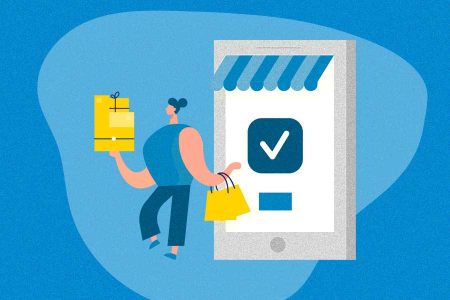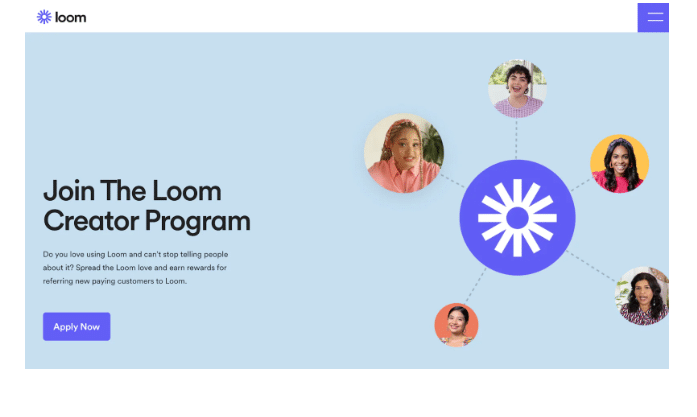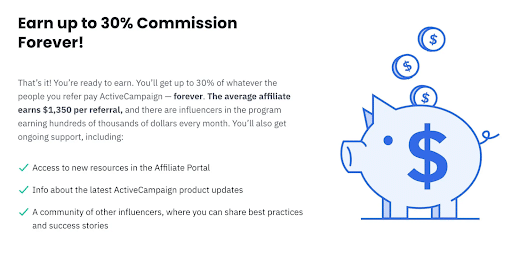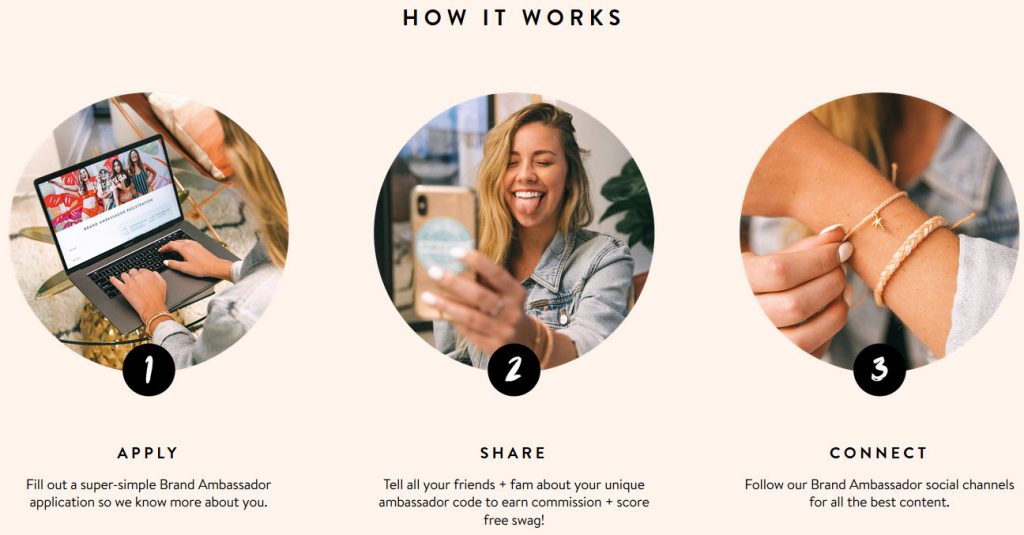One of the most effective ways to grow your customer base is by using customer affiliate programs. Customer affiliate marketing programs leverage the trust of existing customers to promote your brand. These customers understand the products and services. In turn, they can vouch for the brand to family, friends, and followers on their online networks, and help you bring in new customers.
Our guide explores how you can pick and convert an existing customer into the best affiliate for your brand.
Let’s dive in!
What are customer affiliate programs?
A customer affiliate program is a type of affiliate marketing that specifically utilizes existing customers as affiliate partners.
In customer affiliate programs, your online business recruits customers who are already creating content – such as bloggers, regular social media posters, YouTube channel owners, podcast hosts, or email marketing creators – to promote your company’s products or services.
These creators (now known as customer-affiliates) place affiliate links to your business’ website on their own blogs, websites, social media pages, or other channels that they own. By clicking the affiliate link, the audience can view and buy your products.
Every time someone clicks on an affiliate’s link and makes a purchase, you reward the affiliate’s marketing efforts with attractive commissions. Likewise, the program drives traffic and conversions to your business to grow its revenue. It’s a win-win!
 Why does customer affiliate marketing work so well?
Why does customer affiliate marketing work so well?
An existing customer is an asset to your business for countless reasons. Businesses with happy customers get steady positive feedback and brand loyalty. The positive feedback acts as a potent vote of approval, attracting more buyers to your brand. It makes sense to use this feedback to your advantage, and recruit customers as affiliates.
For starters, existing customers know and love your products and services. They can share these products’ key attributes with minimal or no training, increasing brand awareness.
Second, your customers speak the language of their target audience. For example, they may respond to a question from their followers by sharing a positive experience with your products and services. This creates relevant, new audiences for your brand.
Customer-affiliates can share how they authentically use your products or services in real life, for the most genuine promotion. And if a customer is already promoting you without prompting, they’ll likely want to promote you long-term for rewards (including a possible passive income stream).
Next, most shoppers rely on referrals and product reviews from family and friends when shopping online. When these referrals come from your existing customers, especially those with an online following and quality content, they become a powerful marketing tool – better than mainstream brand media advertising. People trust their peers’ word-of-mouth sharing far more than they trust ads and messages that come straight from your brand, so they’re more likely to purchase when a customer promotes you.
Finally, customer affiliate programs are cost-effective and low-risk. After all, affiliate marketing is performance-based. This means your business only pays for actual sales, and you won’t pay upfront or pay for traffic that doesn’t result in a purchase. So, customer affiliate programs are accessible for startups and small businesses with strict marketing budgets, and work well for beginners in the affiliate marketing space.
Is a customer affiliate program right for your business?
Customer affiliate programs aren’t right for every business. Instead, your business must assess its marketing needs and goals to determine if this digital marketing strategy is the right fit.
Here is a quick checklist:
- Are some of your existing customers content creators with a significant following?
- Are your customers willing to recommend your products and services to their online audience?
- Do your products or services appeal to a fairly wide audience?
- Do you know of customer-creators with audiences that match your business’ audience?
- What are the profit margins for your direct sales?
- Are you willing – and able – to pay a cash commission on every sale?
- Can these profit margins accommodate the extra cost of paying your affiliates, including:
- Staffing costs if you decide to have an affiliate manager?
- Collateral creation for the affiliates?
- Affiliate management software costs?
- Do you want customers to recommend you to audiences largely made up of people they don’t know personally?
Did you answer YES to everything in the above checklist? If so, go ahead and use customers as affiliates. Otherwise, consider using referral marketing programs instead.
If an affiliate program isn’t right for your business, a referral program will usually work well.
- Referral programs focus on activating all customers’ sharing, as opposed to working with just the customers who are content creators.
- Customers recommend your brand to people they know using their unique referral link.
- You can reward customers with incentives other than cash.
- Referral programs are also low-cost, as you’ll only pay when a referral results in a sale.
One way to keep your costs in check is by opting for flexible affiliate management software, like Referral Rock software. Use it to switch back and forth from an affiliate program to a referral program as necessary.
Customer affiliate marketing best practices
Use customers as affiliates, and set yourself up for a successful affiliate marketing program, by observing the following best practices:
Start with a brand worth referring
Ensure your existing customers are happy with your products and services. That way, they will refer your brand to their peers. Have a reliable customer service desk reachable 24/7 via channels convenient to your customers. And deal with customer complaints as they arise.
Also, opt for a unique and memorable brand. Here, research your existing customers and their online presence. Next, define your unique value proposition, ensuring it is irresistible to both affiliates and potential customers. Finally, become the pacesetter by keeping tabs on your competitors.
Set program goals
Target conversion rates from the program in a given timeframe, and target amount of revenue generated in a given timeframe, are the most important goals to set
You might also measure traffic brought in, leads brought in, affiliate engagement with the program, or average order value from the program. Then, decide on your target for each metric to generate specific sales in a given timeframe.
Choose the right commission rate
Businesses calculate affiliate commissions as either a percentage of the sale or a flat fee. A typical customer affiliate marketing program pays commissions of between 5% and 20% of the selling price. Still, you may find brands offering commission payouts as much as 50%, depending on their industry.
The rate you choose should depend on the strength of your brand, the dynamics of the target audience, current product prices, the extent of competition in your market niche, and your set marketing budget.
Here’s what to consider when you set your commission rate:
- Commissions should be worthwhile for affiliates but reasonable for your business.
- They should be in cash, even for customer-affiliates (you can offer brand-related perks as added incentives, but affiliates want cash).
- Only pay a commission when a sale is made (don’t use pay-per-click, as that makes it easy for unethical affiliates to game the system).
- Consider offering commission bonuses to your top affiliates who meet certain revenue goals, or who fall into a given top percentage of your affiliates. This will better recognize affiliates who go above and beyond.
Decide on other program terms
Apart from commission rates, you’ll also need to consider other terms of your program. For instance, how will you allow affiliates to promote and distribute their affiliate links? Which marketing channels can they use? And how long will affiliate cookies be active (how long are affiliates eligible to earn a commission after someone clicks on their affiliate link)?
Plan to offer brand-related affiliate perks
Brand-related affiliate perks are non-cash incentives offered as compensation to affiliates. The perks are available as an addition to the set commission. They include first access to new products, discount coupons and store credits, free subscriptions, and prizes.
Affiliates can try the new products for free or at a discounted price and share their experiences with their audiences – plus, discount codes that motivate their audiences to spend more in your store (and generate more commissions for them). Likewise, they can hold contests and reward winners with attractive prizes and store credits, which might attract more leads to investigate your business as well.
Set up your program with affiliate software, not a network
Now that you have your customer affiliate marketing program, will you work with an affiliate software or network? Well, it all boils down to data ownership.
Affiliate software lets you control your data and how you run the program, so you can make meaningful changes based on results. It tracks your affiliate sales, and automatically pays commissions to affiliate accounts once earned. You can track affiliates’ performance in close detail, because program data is yours to access. Also, you can access an interactive dashboard to compare affiliates’ performance at a glance.
Only affiliate software lets you choose and register any affiliates, including your customers. Plus, software makes it easy to communicate with affiliates and keep them engaged.
With software, you won’t risk losing your customer affiliates to other programs or competitors. After all, your program stands alone and isn’t listed next to other affiliate programs like on a network. You’ll be able to foster meaningful relationships with affiliates (relationships that are more than just transactional, and that have no middleman involved.)
In contrast, affiliate networks refer to a pool of affiliates, usually influencers, who connect to reach a larger audience. Affiliate networks charge their members setup, monthly, and override fees – so, they’re a lot more expensive to use than affiliate software is..
Networks limit you to the affiliates already registered on their networks. And not all affiliates in a particular network are your existing customers. Plus, working with an affiliate network may result in losing control over your data – the networks own your program data and can release or withhold it at will.
Also, on networks, you’re directly competing with other affiliate programs, and affiliates can “shop around” for the best commissions. Since programs on a network directly compete with each other, you may lose some existing customers to other competitors’ affiliate programs.
Figure out the best customer-affiliates for your brand
It’s time to shortlist existing customers to determine which are ideal for a customer affiliate marketing program. The right affiliates are existing customers who:
- Create regular content on their online platforms
- Have online content that aligns with your brand identity
- Have a reasonable and engaged following that can generate significant sales for your business (it doesn’t have to be super large, as long as that following is engaged)
- Have a target audience that identifies with your brand’s audience, and that could benefit from your brand
Or, a business can invite its existing customers to apply for affiliate positions with the organization, via an application page. Screen the applications based on customer feedback, and based on if they have real experience with a particular product. Include questions about what they love about your product, so you can effectively limit the pool to only people who have used your product before.
Reach out to the customer-affiliates you want
If you decide to reach out to existing customers instead of waiting for them to come to you, ensure you do your background research. That is, scrutinize their online content to determine its usefulness to your brand. For example, an existing customer promoting competitor brands on their online platforms may not be the ideal candidate for you. In contrast, invite an existing customer who frequently features your products on their online platforms to earn a commission from them.
Here’s how to reach out if someone is a good fit:
- Follow and engage with their content a bit before you reach out.
- Then email or DM them to ask if they’d like to be your affiliate.
- Recognize their loyalty as a customer and the content they’ve created that you enjoy.
- Invite them to the program and explain how it works.
- Offer the commissions and other perks.
- Lay out their responsibilities as an affiliate.
Create an affiliate agreement
The customer affiliate agreement is a legally binding contract between the brand and affiliates. It details the responsibilities and obligations of all parties in the customer affiliate program. Ask the affiliates to sign this affiliate agreement before they start promoting your products on their online platforms.
Here are the terms you can usually find in a customer affiliate marketing agreement:
- Length of commitment (usually, the contract is perpetual until your business or the customer-affiliate chooses to end it)
- Relationship between you and the affiliate (the customer-affiliate stays a third-party and doesn’t become an employee of your brand)
- Terms for promotion of your products
- Rules for use of the affiliate link
- Commission-related terms
Communicate well with affiliates
Once they’re on board, provide your affiliates with the necessary resources to perform well in the program. Guide them on how to use the affiliate software to track their performance, and give them assets to use in promotions, like banners, images, and other marketing materials. You might also opt to offer tutorials, YouTube videos, or webinars to equip them with everything they need for success.
Stay in touch to relay brand news and events, product updates, and changes in the affiliate program. For example, have a 24/7 helpline or chatbot for your affiliates. And create a social media community where affiliates can share their experiences, tips, and challenges with other affiliates, and talk with your brand representatives. Finally, consider checking in with individual customer-affiliates on Zoom, and discussing their performance
Wrapping up
Leveraging customers in your affiliate marketing strategy usually generates better revenue than ad-based marketing campaigns. Customers with an online following can influence their audience to buy your products and services. The affiliates earn a lucrative commission and brand-related affiliate perks in return. And your business can use affiliate tracking software to keep tabs on your affiliates’ performance, so you’ll always know whether your campaign is a success.

 Why does customer affiliate marketing work so well?
Why does customer affiliate marketing work so well? 





